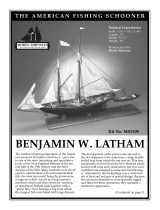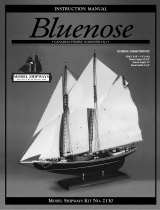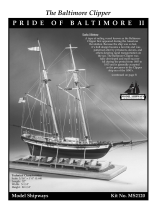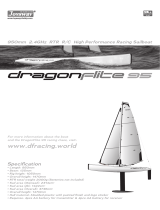Page is loading ...

ASSEMBLY INSTRUCTIONS SAN FELIPE
BEFORE STARTING, MAKE SURE YOU HAVE ALL THE SUPPORT MATERIAL FOR ASSEMBLING THE
MODEL:
- Assembly Instructions
- Step by step photos
- Plans
PREPARING THE MATERIAL:
In order to correctly identify the precut parts, before removing them from the wooden sheets, mark on them the same numbers
that appear on the “PI” (Part Identification) Sheet included with the instructions.
STARTING THE ASSEMBLY:
Using a cutter, and making sure you do not put your fingers along the cutting line, remove the parts from the wooden sheets,
eliminating the small sprues that hold them in place. In continuation smoothly sand down the parts, using fine grain sandpaper,
to eliminate the pickup of the parts. The numerical order indicates the order in which the different parts must be made up and
fitted.
STRIPS AND RODS:
These models incorporate a variety of different types of strips and rods with which to make up the different parts of the kit. The
list of parts proportions information on the type of material and measurements. In some cases it is advisable to adjust the
measurements on the basis of the model itself, as assembly progresses. In this way you will achieve a better fit.
IDENTIFICATION OF WOODS:
Ramin wood: Yellowish tones
Sapelli wood: Reddish tones
African walnut: Brownish tones
Embero wood: Grainy brown tones
CUSTOMER ATTENTION SERVICE
In the case of whatsoever doubt or further information that you may require regarding the assembly of our products please
contact our Technical Service at the address www.occre.com. We will be delighted to attend to you.
HULL
PHOTO 1 to 6. Start by gluing parts 1, 2 and 3 that make up the false keel together with the supports 4. Following the numerical
order shown by the photos, position ribs 5 to 18. Before gluing the ribs, check they fit correctly by inserting them until the "stop"
in the corresponding slits of the false keel, A1. It's important the ribs are completely perpendicular to the false keel to ensure the
decks fit properly afterwards. Use white glue for this (wood glue).
PHOTO 7 and 8. Cut to size and glue two 19 parts.
PHOTO 9 to 11. Apply adhesive and glue in place decks 20, 21 and 22. Cut to size and glue two 19 parts. Glue part 23 and
stain the top a walnut colour.
PHOTO 12. Cut parts 25 to size. Then arrange them in groups of 10 and shade in with a pencil.
PHOTO 13 to 19. Line deck 24 with the strips 25. Use contact glue (shoe glue). Using a wooden handle as a tool, press the
strip against the deck to make sure it's firmly attached. Position the deck upside-down and cut any excess off the strips, as
shown in the photos. Then mark two dots where the strips join to simulate nails. Note that the back of the deck is not lined. This
will be lined later on, when the rest of the decks are in place.
PHOTO 20. Glue the prepared deck onto the ship structure. It's important for the deck to be supported correctly by the ribs. Use
instant glue (cyanoacrylate).
PHOTO 21. Apply adhesive and glue two 19 parts.
PHOTOS 22 to 24. Line deck 26 with the strips 25. Mark the dots as on the other decks. Glue the deck onto the hull structure.
PHOTO 25 and 26. Cut the stick that's visible through the deck hole.
PHOTO 27 to 30. Glue deck 27 and line it up to the end.
PHOTO 31 to 33. Glue parts 28, lined up with the holes in the deck.
PHOTO 34 and 35. Glue deck parts 29 and line them up as shown in the photo.
PHOTO 36. Cut and glue parts 19.
PHOTO 37 to 39. Line deck 30 with the strips 25. Then glue the deck onto the ship.
PHOTO 40. Cut and glue parts 19.
PHOTO 41 to 45. Line bulkheads 32, 33 and 34 with the strips 32. Glue each bulkhead in its corresponding position.
PHOTO 46. Glue part 35.
PHOTO 47 and 48. Line deck 36 with the lining 25. Insert and glue the deck onto the ship structure.
PHOTO 49 and 50. Cut and glue sticks 37 to 42. Then finish with a file.
PHOTO 51 to 53. Glue parts 43, 44 and 45 and line up with parts 46 and 47. Glue the structure onto the ship.
PHOTO 54 to 56. Insert and glue deck 48. Then glue supports 49 to 55 to both sides of the hull.
PHOTO 57 to 60. Line deck 48 with the strips 56.
PHOTO 61 to 63. Glue the end facings 57 to 62.
PHOTO 64. File the sides of the hull where the parts 63 will be supported.
PHOTO 65 to 72. Glue part 64 onto part 63. Then stain the inside of part 63 a walnut colour. Glue and nail part 63 onto the hull
with the tacks 65. Do the same on the other side of the ship.

PHOTO 73 to 80. Glue parts 64 onto part 67 then stain it a walnut colour. Attach the part to the hull using the tacks 65. Do the
same on the other side of the hull.
PHOTO 81 to 86. Start sanding the hull from the bow down to the stern. For the more curved areas, use a sanding block or half-
round file. Adjust and fit a stick 68 into the grooves in the ribs. The sanding should be progressive to ensure the lining sticks are
well-supported but without deforming the ribs, which give shape to the hull. The supports should be adjusted, both at the bow
and the stern, to achieve a continuous, smooth shape so the hull can be lined with sticks. Check the photos to see how the
sanded hull should look. The hull should be sanded on both sides to ensure a symmetrical finish.
PHOTO 87 to 93. Soak a stick 68 in water for about 20 minutes to make it flexible. Then add glue and attach it, fitting it into the
grooves in the ribs. It must overhang the hull at the bow. Nail it with tacks and cut off any excess. Then glue another stick so
that it overhangs the stern of the hull. The same thing should be done on the other side of the hull.
PHOTO 94 to 99. Fit and glue parts 69 and 70 and nail them with tacks 65. Glue parts 64 on the inside, as show in the photo.
PHOTO 100 to 102. Stain the inside of part 71 a walnut colour and glue it to the centre of the hull.
PHOTO 103. Cut and glue parts 72 to 75.
PHOTO 104 to 113. Check and glue parts 76 and 77 with the tacks 65. Glue parts 64 on the inside.
PHOTO 114 and 115. Apply colourless primer to all the decks. Primer should be applied several times, sanding between coats,
until a satisfactory finish is achieved. Then wipe over with a pan scrubber to reduce the shine.
PHOTO 116 to 126. Start to line the hull by gluing sticks 78 and using tacks 65 in the zone of the false keel. The sticks should
join at a rib and cover the whole length of the hull. These sticks must be glued to the ribs and to each other using white glue
(wood glue) to achieve a solid hull. The sticks should be adjusted as you go along. You'll see some wedge-shaped gaps will
form, which you'll have to fill in later.
PHOTO 127 to 129. Build the two symmetrical steps with parts 79 a 84. Then stain them a walnut colour and glue them onto the
deck.
PHOTO 130 and 131. Cut to size and glue the grille 85. You'll see it's made from a material that's easy to cut. Then glue the
end facing 86.
PHOTO 132 to 135. Cut the sticks 87 to size and glue them to make ladders with the parts 88. Attach the parts with instant glue.
PHOTO 136. Glue one of the ladders into the hole in the deck.
PHOTO 137 to 142. Continue lining the hull with sticks 78. Cut the sticks to ensure the holes in the bulwarks aren't covered.
PHOTO 143. Build two more steps with parts 79 to 84 and glue them as shown in the photo.
PHOTO 144 to 149. Frame two of the portions of grille 85 with the sticks 89 and 90. Apply primer to the frames. Then glue the
resulting grilles, as shown in the photo. Adjust and glue parts 91 and 92. Insert and glue the other ladder as shown in the photo.
PHOTO 150 to 162. Continue lining the hull with sticks 78 and tacks 65. As you go along, cut the sticks to ensure the proper
shape is maintained. Make wedges to fill in the triangular holes. Measure the hole to be filled in and cut the stick to size. Then
attach it using white glue.
PHOTO 163 to 170. Sand the whole hull to make it even and achieve a uniform surface. Various types of files can be used for
this.
PHOTO 171 to 178. Stain parts 93 to 96 a Sapele wood colour and build the deckhouse. Then varnish it. Cut part 100 to size
and glue it to the inside.
PHOTO 179 to 181. Build two symmetrical steps with parts 79 to 84 and 101. Stain them a walnut colour and glue them onto
the deck. Also glue the deckhouse and parts 102 and 103.
PHOTO 182 to 187. Line the stern transom and bow bulkhead with parts 104. Use contact glue.
PHOTO 188 to 194. Start lining the hull with lining 105. Use contact glue.
PHOTO 195 to 198. Build the capstan with parts 106 to 108. Then attach it to the centre of the deck.
PHOTO 199. Glue the parts 109.
PHOTO 200 to 202. Continue lining the hull up to the top, using parts 105.
PHOTO 202 to 207. Cut a grille 85 to size. Frame it with parts 110 to 112. Glue it onto the deck, as well as part 113.
PHOTO 208 to 223. Continue lining the hull with parts 105. Check the fit of parts 114 and 115. Once the hull has been lined, it
should be sanded gently to even up the surfaces and make it smooth to the touch. Be careful not to overdo this as the lining is
very fine. Then adjust and use parts 117 and 118 to line parts 114 and 115. Insert and glue parts 114, 115, 116 and 119. Line
the gallery with parts 120 cut to size.
PHOTO 224 to 227. Sand and even up the gallery and line with parts 121.
PHOTO 228 and 229. Cover part 122 on one side with parts 124 and the other side with parts 123. Then insert and glue it.
PHOTO 230 to 235. Adjust and glue parts 125 to 130. Finish with parts 131.
PHOTO 236 to 241. Adjust and glue sticks 132 to complete the length of the hull. Also glue parts 133. Even up the joins of the
sticks with a sanding block.
PHOTO 242. Glue and adjust parts 134.
PHOTO 243 to 246. Glue parts 135, centred, on parts 132. Use various sticks to complete the whole length of the hull.
PHOTO 247. Cut to size and glue two of parts 136 to 139.
PHOTO 248. Cut and glue parts 140.
PHOTO 249 to 252. Use a 140 stick to mark and cut to the necessary length, then glue another 140 stick above the previous
one. Glue another 140 stick and sand to even up. Do the same on the other side of the ship.
PHOTO 253 to 257. Make a grille with parts 85, 141, 142, 143 and 144. Then varnish and glue it onto the deck.
PHOTO 258 to 260. Cut to size and glue parts 145 onto the bulwarks on both sides of the ship.
PHOTO 261 to 265. Cut and glue parts 146 to 150.
PHOTO 266 to 274. Adjust and glue parts 151 to 158 to both sides of the hull.
PHOTO 275 and 276. Gently sand the whole hull and apply a colourless primer. Follow the manufacturer's instructions.
STRUCTURE
PHOTO 277 to 284. Stain parts 160 to 164 a walnut colour and then varnish them. Outline them with a black marker pen. Then
glue the pieces onto the hull.
PHOTO 285 to 289. Build the rudder blade with parts 165 to 168. Some of the parts will have to be cut to size. Then varnish and
attach the blade to the ship.
PHOTO 290 to 292. Stain parts 169 to 171 a Sapele wood colour and attach them.

PHOTO 293 to 308. Adjust and glue parts 172 to 187. Parts 173 should be painted gold. Make holes to be able to nail the parts
172. Parts 185 should be painted copper or a similar colour.
PHOTO 309. Glue four 185 parts.
PHOTO 310 and 311. Stain parts 188, 189 and 190 a Sapele wood colour and glue them. Parts 188 and 190 should be
previously curved and stained a Sapele wood colour.
PHOTO 312 to 314. Continue gluing parts 173 and 191 to 194.
PHOTO 315. Cut the strakes to be able to glue parts 195, lined up with the holes.
PHOTO 316. Stain parts 196 to 198 a walnut colour and glue on parts 199. Then varnish them.
PHOTO 317 to 319. Stain parts 200, 201 and 202 a Sapele wood colour. Glue parts 196 to 202 to both sides of the ship.
PHOTO 320 to 330. Make and paint parts 203 to 218 as shown in the photos. Then glue them onto the ship.
PHOTO 331 to 340. Make parts 219 to 230. Varnish the parts that require it and glue them onto the ship.
PHOTO 341 to 347. Wind the thread 232 around a 231 part and plait it. Then insert and attach it to the hull using tacks 233 and
cut off any excess. Repeat this process to complete the parts as shown in the photos on both sides of the ship.
PHOTO 348 and 349. Cut and glue parts 223, 234 and 235.
PHOTO 350. Paint part 236 gold and decorate it. Then glue it in place.
PHOTO 351. Make and glue two 237 parts.
PHOTO 352 and 353. Decorate and glue parts 238.
PHOTO 354 and 355. Build the helm with parts 239, 240 and 241. Attach this to the deck.
PHOTO 356 to 364. Pain all the zones indicated in the photos an ultramarine blue. Make and glue parts 242 to 248. Paint the
centre of the portholes black, as well as the zone indicated of the stem.
PHOTO 365. Attach and glue parts 249 and 250 on the upper batteries on both sides of the ship.
PHOTO 366 to 372. Make, decorate and glue parts 251 to 256.
PHOTO 373 to 375. Make and attach parts 257 to both sides of the hull.
PHOTO 376 to 379. Decorate and glue parts 258 and 259 and parts 173.
PHOTO 380. Cut and glue parts 260.
PHOTO 381 to 384. Paint parts 261 and 262 a copper colour or similar. Insert parts 262 into the 261 parts and glue them onto
the lower batteries of the ship. Make a hole in the centre of each porthole.
PHOTO 385 to 388. Curve and adapt part 263 to the hull. Then decorate it as shown in the photos, in black, gold and red. Glue
into place.
PHOTO 389. Cut to size and attach part 265 using parts 264. Holes of ø 0.8mm should be made previously.
PHOTO 390 to 396. Decorate and glue parts 266 to 271.
PHOTO 397. Paint the 272 parts a copper colour or similar and the 273 parts gold and red. Then glue the parts as shown in the
photo.
PHOTO 398. Curve and glue parts 274.
PHOTO 399. Decorate and glue parts 275 to 278.
PHOTO 400. Bend parts 279 and glue them to both sides of the hull. Cut and glue parts 280.
PHOTO 401. Insert and glue parts 185 and 278 on both sides of the ship.
PHOTO 402 to 405. Decorate the parts by painting them gold, black, red and blue and glue them as shown in the photos.
PHOTO 406 to 408. Paint the 272 parts copper and the 273 parts gold and red. Then glue the parts as shown in the photos.
PHOTO 409 and 410. Decorate parts 289 and 290 black and gold. Then glue one on each side of the hull.
PHOTO 411. Decorate and glue two 223 parts onto the deck.
PHOTO 412. Cut and glue parts 291.
PHOTO 413 to 419. Paint parts 292 and 296 dark brown. Make and glue the other parts. Paint the 293 parts red and the 295
parts black. Glue the boats as shown in the photos.
PHOTO 420 to 424. Decorate and make parts 297 to 299. Glue the parts onto the ship.
PHOTO 425. Paint the parts 300 and 301 black and gold and glue them to the hull.
PHOTO 426. Insert and glue two 302 parts.
PHOTO 427 to 429. Paint them black and ultramarine.
PHOTO 430 and 431. Decorate parts 300 to 303 and glue them.
PHOTO 432. Make and glue parts 304 and 305.
PHOTO 433. Decorate and glue parts 306.
PHOTO 434 to 436. Glue the parts 307.
PHOTO 437 to 440. Curve and glue parts 308 and 309. Decorate and glue parts 307 to 312.
PHOTO 441 and 442. Paint the 313 parts black and gold and glue them to both sides of the ship.
PHOTO 443. Glue the parts 307.
PHOTO 444 and 445. Decorate and glue parts 314 and 315.
PHOTO 446 to 449. Glue and paint the parts 316 and 317 black and brown ochre. Add parts 318 to 322.
PHOTO 450 to 454. Paint the end of the davit gold. Insert part 302 into it. Knot a 323 thread to part 302 and pass it through as
shown in the photos. Insert and glue thread 319 onto the hull.
PHOTO 455 to 457. Decorate and glue parts 324, 325 and 326 black, gold and red. Glue them as shown in the photos.
MASTS AND SPARS
In order to make up the masts the first step is to cut the rods to size, as indicated in the parts list, or by taking measurements
directly from the plans, which are printed in 1/1 scale.
All of the masts and yards have to have a certain conical shape, which you must give them.
In order to achieve this conical shape for the masts, sand down the rod (using a sander), increasing the amount of sanding
down as you get closer to the end at which you want to decrease the diameter. Turn the rod so that you sand it down evenly on
all sides, until you have achieved the diameter indicated in the plan.
To get the conical shape of the yards carry out the above operations but in this case evenly reducing the diameter at both ends
of the yard.
In order to make up the mast for this model correctly you must take the following into account:

- The plans
- The close up photos of the masts
- The measurements and material descriptions of the parts list
- The parts identification (PI) sheets
The masts must be varnished and some of the parts that make them up will have to be painted. See the general close up
photos of the masts.
Once the mast has been assembled and varnished attach the tackle (slings, blocks, eyebolts, clump blocks, etc.) and attach
them to the ship.
The mast must be inserted until it comes up against the mast step in the false keel.
SAILS AND RIGGING
In order to make up the running gear for this ship follow the alphabetic order of the figures printed in the plans, indicating the
order for fitting the (ropes, clump blocks, blocks, sails, etc.) highlighted in red. In combination with the parts list this will serve as
a guide with regard to the type of material to be used.
To simulate the aging of the sails you can boil them in tea and leave them to dry all wrinkled up. Fit them in place without ironing
so that they will have some consistency.
/








